Exploring the Ant on a Rubber Rope Paradox: A Mathematical Journey
Written on
Understanding the Ant on a Rubber Rope Paradox
The Ant on a Rubber Rope paradox serves as a fascinating illustration of how intuition can sometimes mislead us when confronted with mathematical reasoning. The scenario begins with an ant traversing a one-dimensional rubber rope. This rope, being infinitely elastic, can stretch indefinitely in its length.
Imagine that the rope initially measures 1 kilometer and the ant starts at the end of this rope. As the ant moves forward at a speed of 1 centimeter per second, the rope simultaneously stretches uniformly at a rate of 1 kilometer per second. The crux of the paradox lies in the question: will the ant ever reach the end of the rope?
Instinctively, one might argue that the ant is doomed to fail, as the rope is extending at a pace much quicker than the ant can crawl. However, mathematical reasoning suggests otherwise! Intrigued? I certainly was when I first encountered this enigma. In this discussion, we will explore a simplified mathematical approach to tackle this problem in the discrete realm, and later, we will briefly glance at a continuous domain approach.
Discrete Domain Analysis
The discrete approach simplifies the problem, making it easier to solve. Let’s assume that the rope stretches instantaneously at the end of each second. This slight modification gives the ant a fairer chance compared to the original scenario. To generalize the problem, let ‘t’ denote time.
At the outset, when t = 0 seconds, the rope's initial length is represented as ‘l’ units, and the ant starts at a position of x = 0 units (the left end of the rope). As the clock begins, the ant crawls at ‘a’ units per second while the rope stretches at ‘v’ units per second.
Now, let’s delve deeper into how we can mathematically analyze this situation.
The Mathematical Framework of the Paradox
The ant's goal is to reach the end of the rope, initially positioned at ‘l’ units. However, every second, this target moves in the x-direction at a rate of ‘v’ units per second.
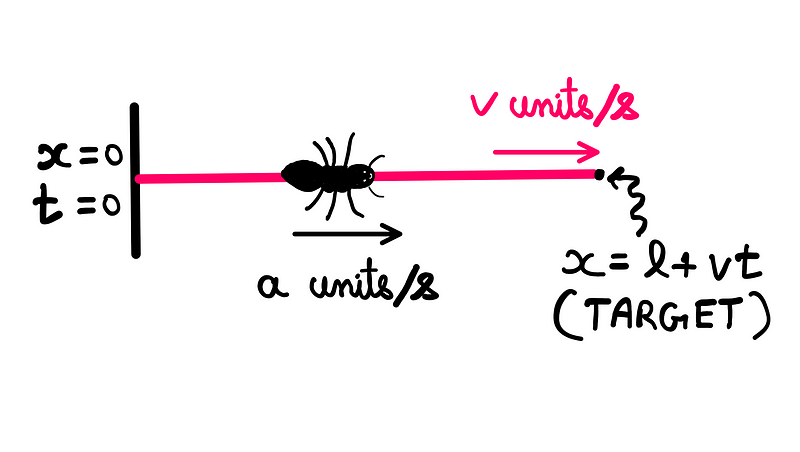
Thus, the target position at any time ‘t’ can be calculated as follows:
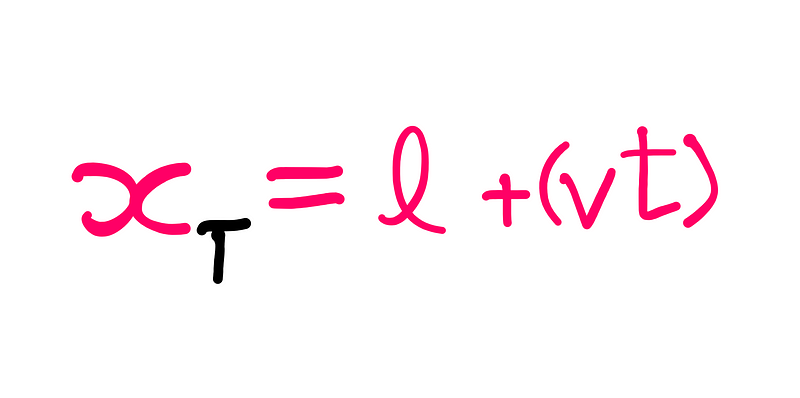
At the conclusion of the first second, the ant has covered ‘a’ units, while the target has moved to x = l + (v*1) = (l + v) units. Following this logic, at the end of two seconds, the ant would have traveled another ‘a’ units, and the target would be at x = l + (v*2) = (l + 2v) units.
Consequently, the ratio of the distance covered by the ant, denoted as F(t), can be described as follows:

For the ant to succeed in reaching its destination, F(t) must be equal to or exceed ‘1’.
To investigate what occurs at t = k seconds, we represent this series with the equation:
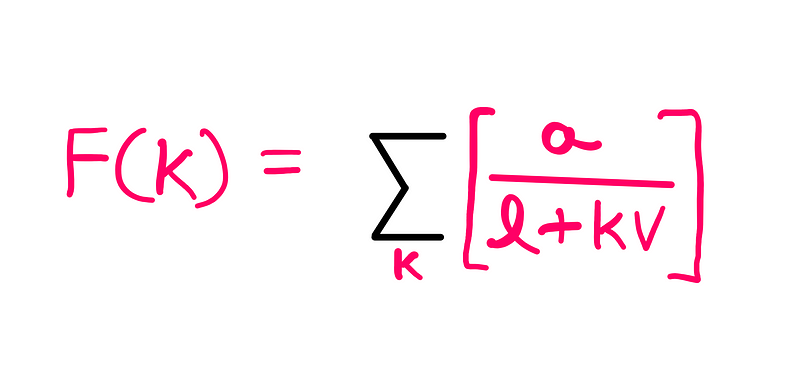
Let's enhance F(k) by including the ‘l’ term in the denominator multiplied by ‘k’, resulting in a new ratio G(k). As long as k is greater than zero, it follows that F(k) ≥ G(k) for k > 0.
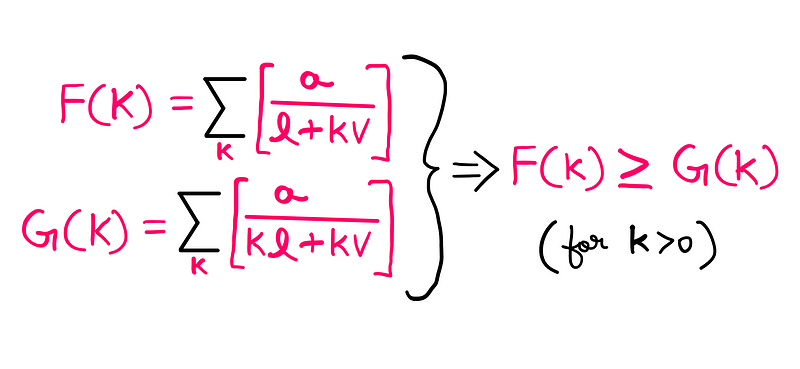
From this relationship, we can conclude that if G(k) reaches at least a value of ‘1’ for some ‘k’, then F(k) must also be at least that value. By factoring out ‘k’, we obtain:
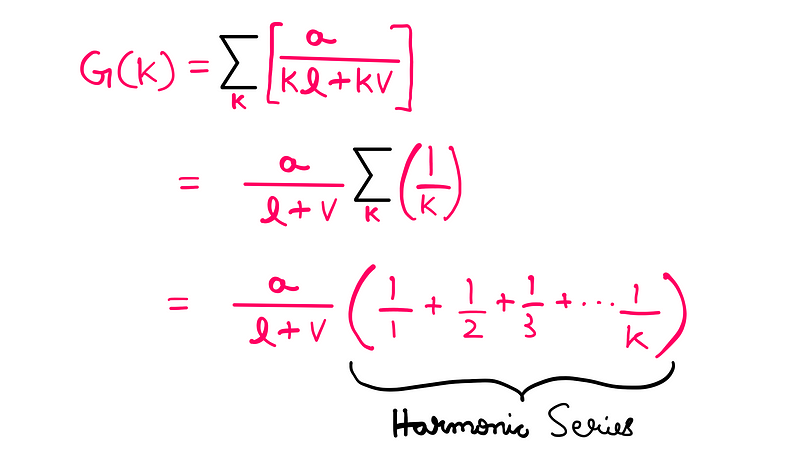
This series is known as the harmonic series, which diverges. For further understanding of convergence and divergence, refer to my essay on limits.
Given that we are dealing with a divergent series, there is no upper limit, suggesting that there exists a value of ‘k’ for which G(k) approaches 1:
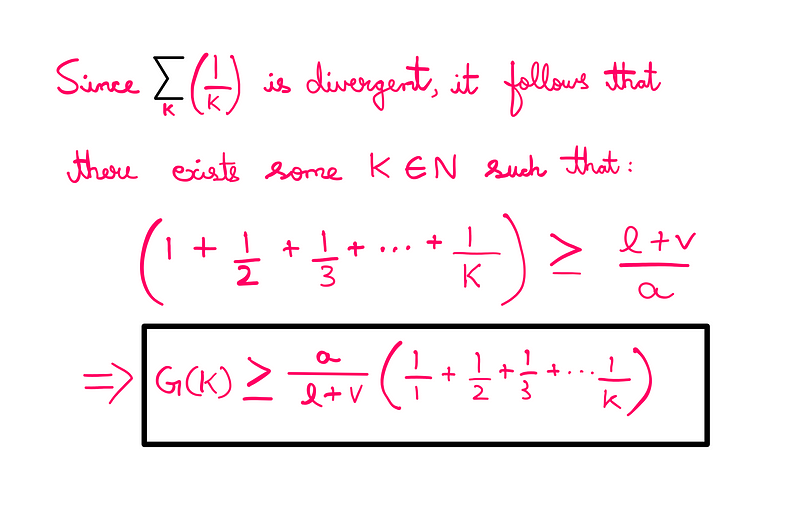
Thus, the ant will eventually reach the end of the rope, provided it has sufficient time.
Continuous Domain Solution
While the continuous domain can also address this problem using calculus, it involves more complex mathematics, which I plan to cover in a future calculus series.
For now, it suffices to say that with a = 1 cm/s, v = 1 km/s, and l = 1 km, the solution yields:
k = (e¹????? — 1) ≈ 2.8 * 10³² seconds.
To put this into perspective, the estimated age of our universe is about 4 * 10¹⁰ seconds. Hence, we have a long wait ahead before the ant reaches the end of the rope (roughly 2.8 * 10³² km).
Intuition Behind the Paradox
When we manipulate the numbers and lower the scales, we can visually interpret the outcome. In the example below, the rope expands at a rate of 2 cm/s from an initial length of 4 cm. The red dot (representing the ant) crawls at 1 cm/s and reaches the end of the rope in 12.8 seconds.

This paradox serves as a compelling analogy for how light from distant galaxies travels through our expanding universe. The universe acts as the stretching rope, while the light beam symbolizes the ant.
It is noteworthy that light may never reach the far edge of our universe due to its accelerating expansion! The problem we analyzed assumed constant rates.
Postscript
A valuable observation from reader Dan Foley highlights the importance of recognizing that the rope stretches uniformly along its entire length, rather than merely adding length to the far end each second.
This distinction is crucial because, if the length were simply added to the end, the ant would indeed be left behind. The uniform stretching allows for the portion of the rope behind the ant to grow, ultimately aiding its progress toward the target.
For readers interested in exploring more of my work, a comprehensive MAP is now available on my about page. Enjoy!
Reference and credit: Martin Gardner. You can read the original essay here.
The first video titled "Ant On A Rubber Rope Paradox" provides a detailed explanation of the paradox and its implications.
The second video, "An Intuitive Solution to the Ant on Rubber Rope Paradox," offers a more visual and intuitive understanding of the concepts discussed.